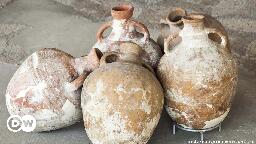Surprising facts about amphorae — antiquity's packaging



Amphorae were made primarily for trade. In ancient times, people used these vessels, which held five liters (1.3 gallons) to 80 liters (21 gallons) depending on their size, to transport oil, wine, honey, olives, pickled vegetables and garum — a fermented fish sauce that was as popular with the Romans as soy sauce is today in Asian cuisine.
A typical amphora is tapered at the bottom, which meant that it could only stand on a rack or had to be embedded in the ground. But that shape was ideal for transport by ship, as the vessels could be stored side by side and on top of each other to save space. Large sailing ships had up to 10 thousand amphorae on board. The carrying handles on both sides are an important feature to which this container owes its name. The term comes from ancient Greek and means "two-handled clay vessel."

The idea that archaeologists will be analyzing rusty beer cans or plastic beverage bottles and displaying them in museums 400 years from now seems strange to us. But amphorae and modern beverage containers are not that dissimilar. In ancient times, amphorae were disposable products. Unless they were ornately designed, they came in standardized sizes — an ancient ISO standard. Producing them was cheap.
Among other things, the vessels were marked with how heavy they were, where they came from, what goods they contained and when they were shipped by which exporter. When the merchant ships docked at the ports, the amphorae were emptied and had thus fulfilled their function. Afterwards, they were either smashed on the spot and thrown away or repurposed, for example as latrines, coffins, or light and cheap building material.

But that wasn't the case with olive oil vessels, which were shipped in vast quantities in the Mediterranean. They could not be reused, so they were smashed and simply thrown in a big heap or into the sea.
One of these piles grew over the years into a hill almost 40 meters high, which still exists today: Monte Testaccio in Rome, a mountain of shards. Today, it's covered with vegetation, but it's estimated that more than 50 million fragments of ancient amphorae still lie beneath the surface. That's because not even 3,000 years is enough time for clay shards to decompose.
But for archaeologists, such Classical garbage dumps are a treasure, as these finds reveal much about ancient trade routes and people's diet at the time. Based on the origin of the amphorae and their inscriptions, it can be proven that goods were transported throughout the Roman Empire and even exported as far as India and Ethiopia.

The Germans are known abroad for their love of order. So it's small wonder that it was a German who wanted to bring order to the chaos of shards on Monte Testaccio. Archaeologist Heinrich Dressel (1845-1920) examined the Roman amphorae on the hill of shards starting in 1872, and sorted them into more than 40 different types, some of which are still used today as classifications for amphorae. He was interested in the shapes, the contents and the inscriptions of the amphorae. He was able to show that the bulbous amphora of the type "Dressel 20" came from Spain and had contained oil, while the commonly-used elongated amphora of the type "Dressel 1" had been filled with Italian wine

Amphorae were used in huge numbers in the ancient world, and were made of a very robust material, which is why they can still be found today. They're commonly found on the sea floor or on sunken ships. But anyone who comes upon ancient amphorae while diving in Turkey, Spain or Greece should leave them untouched and report the sighting to the authorities.
Anyone removing amphorae or even fragments of them and taking them home can find themselves under prosecution. Exporting cultural goods is illegal and punishable by stiff fines and even prison sentences. In a current case, an Austrian man whose children found amphora fragments while snorkeling in Rhodes in 2019 faces up to ten years in prison because he took the shards home with him
I'm a simple man. I see stuff about the systematic organization of ancient international trade, I upvote.
For amphorae in particular, I love that they were semi-standardized, and I love that shards were repurposed for anything useful.
I too amphoret
I bet the Greeks would know how to use the three sea shells.
They think the three seashells are for babies!
I know the Romans used a sponge on a stick which, while gross to my modern germ-theory-knowing mind, is perfectly sensible from a technique point of view. I'm struggling intellectually to figure out how the ostraca could have been used in way that was both effective and safe, and I'm struggling emotionally with why I care. 🤣